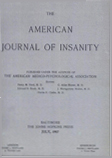Abstract
We have in this rating scheme:
1. A graphic representation of the progress of the case.
2. A graphic representation of those fields of conduct which fall far below or rise above the general condition of the patient.
3. A system which increases the nurse's interest in her work and her sense of value to the hospital. These are times when every mental hospital is meeting face to face a serious problem as regards nursing. It is high time that we ceased blaming this situation upon economic conditions and on the "newer type of women" and that we accept the fault where it lies, namely, that too much have we considered the nurse as the caretaker, and have felt that our scientific research work might perhaps be more easily carried on without interference from "such a class of people." If this work can mean nothing more, I will be satisfied if it could go as an appeal for more co-operation between the medical man and the nurse in the mental hospital.
4. A fixing or crystallizing of the ever flowing personality so that now we have some replacement of the vague terms that we so frequently have to employ.
5. A chart of clinical progress for a comparison with recurrent laboratory procedures on a few cases. We are starting at McLean a number of recurrent laboratory procedures and I have looked in vain for any other satisfactory clinical correlation. For instance, as we are studying attentional disturbances three times a week over a period of six months on certain patients and doing the same on quite a number of the factors of blood chemistry, we have in these charts a mathematical statement, however inaccurate it may be to-day, of the clinical progress of the case. We have applied certain tests of accuracy to this nurse's rating scheme and to some extent I have been satisfied with their outcome, yet it is full of mistakes, but if our theory is correct the system is such that it is amenable to correction and to the extent that the theory is correct, these corrections may be final.
6. Such an application of laboratory analysis to the clinical field as is acceptable to the clinician. So long as the consideration in such a system is one of the usual conduct, no matter how far you subdivide, it is of necessity also an expression of personality.
7. Such a use of highly correlated data together with the employment of the standard deviation as to yield important information. This may be offered, on a purely mathematical basis, as a distinct contribution to the recognized theory of rating schemes.
8. An application in the field of psychiatry of those philosophical notions which have in the last decade been upheld by Pearson and Urban and which go back to the work of Fourrier. If physics and chemistry and biology can accept and employ the doctrine of ultimate analysis on the basis of sine curves, why cannot we do the same? The search for the unanalyzable curves of psychiatry represent the rainbow's end—the pot of gold—but it is worth the trip and this nurse's rating scheme is serving as the first rough map at McLean Hospital for such a journey.
In the American Journal of Insanity, Vol. 71, page 761, appears a description of "The Behavior Chart in Mental Diseases" by Dr. Edward J. Kempf. This article describes a form of nurse's notes still employed at the Henry Phipps Psychiatric Clinic. There are certain valuable pictorial factors in this form of a chart, which, however, seem to the writer not to involve the same fundamental principles as appear in the chart described in this paper.

